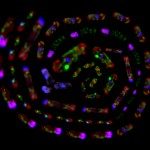Lien vers Pubmed [PMID] – 21819943
C. R. Biol. 2011 Aug-Sep;334(8-9):620-8
Calibration of clocks to date evolutionary changes is of primary importance for comparative genomics. In the absence of fossil records, the dating of changes during yeast genome evolution can only rely on the properties of the genomes themselves, given the uncertainty of extrapolations using clocks from other organisms. In this work, we use the experimentally determined mutational rate of Saccharomyces cerevisiae to calculate the numbers of successive generations corresponding to observed sequence polymorphism between strains or species of other yeasts. We then examine synteny conservation across the entire subphylum of Saccharomycotina yeasts, and compare this second clock based on chromosomal rearrangements with the first one based on sequence divergence. A non-linear relationship is observed, that interestingly also applies to insects although, for equivalent sequence divergence, their rate of chromosomal rearrangements is higher than that of yeasts.


